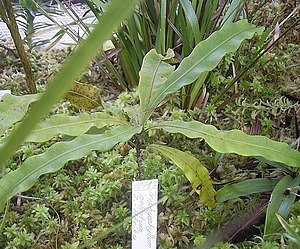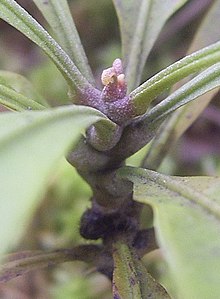Hook blade
| Hook blade | ||||||||||||
|---|---|---|---|---|---|---|---|---|---|---|---|---|

Hook leaf ( juvenile plant) |
||||||||||||
| Systematics | ||||||||||||
|
||||||||||||
| Scientific name of the genus | ||||||||||||
| Triphyophyllum | ||||||||||||
| Airy Shaw | ||||||||||||
| Scientific name of the species | ||||||||||||
| Triphyophyllum peltatum | ||||||||||||
| ( Hutch. & Dalziel ) Airy Shaw |
The hook sheet ( Triphyophyllum peltatum ), also Dreifaltigblatt called, is a plant which, although carnivorous , but only as an option and at times forming traps. It occurs exclusively in some West African rainforests and is the only species of its genus in the family of the hook leaf family (Dioncophyllaceae).
description
Habitus
The hook leaf is a liana with well-developed roots that can reach a length of up to seventy meters with age. The plant goes through three different stages during its development, each with a different leaf shape.
The up to 40 cm long, flat, lanceolate leaves of young plants stand in a cup-shaped manner on closely spaced internodes ; this first stage can take up to several years. When the plant has reached a height of around 35 to 40 cm, it enters its carnivorous stage at the beginning of the next rainy season (around June). This reveals its relationship to the pigeon leaf: it forms, similar to this, passive sticky traps in the form of up to 25 cm long, tentacle-covered catch leaves, which, however, are thrown off after a few weeks. The secretion drops on the tentacles are probably the largest of all carnivorous plants. This enables the plants to hold onto and digest even relatively large prey. Proteases , esterase and peroxidase are found as digestive enzymes . Most prey animals are beetles , as well as millipedes , centipedes , crickets , termites , moths , wasps , mosquitoes and spiders .
The function of the carnivory here is to provide the plant with sufficient nutrients (especially potassium ) for the growth spurt that follows this stage . However, if the nutrient supply is already sufficient, the carnivory stage is left out and the plant starts sprouting immediately.
With the transition to the last, adult stage, the plant forms a shoot with elongated internodes, which is several meters high after a few weeks and can become up to ten centimeters thick over the years. The leaves now formed are very similar to those of the related Nepenthes and have two hooks at the top for climbing.
Inflorescence and flowers
The cultivation of the Würzburg Botanical Garden was reported to have a bloom in May / June. A sympodial inflorescence of up to eighty flowers grows from the leaf axils of the adult plant . On the inflorescence there are five individual flowers on each branch up to two centimeters long. Each flower has an up to four centimeters long, hairless and dark red flower stalk. The flowers are star-shaped, white or pink and small, they have a weak smell and only bloom for one day from daybreak to dusk. Little is known about possible pollinators, the only thing certain is that it must be a day animal, possibly a species of hoverfly . The flowers are self-pollinating .
Fruits and seeds
The seeds are 5 to 8 centimeters in size, tinged with reddish, stalked and disc-shaped. The capsule fruits unfold before the seeds ripen when the few seeds they contain, with their up to five centimeters long stalk attached to the inside of the capsule, are still comparatively small. These grow and mature within two months of flowering during the rainy season. They are considered to be the only known seeds in the plant kingdom that are larger than the fruits they produce. Thanks to their umbrella, the wind can take them far. The seeds germinate cryptocotylar, that is, the cotyledons initially remain inside the seed and only absorb its reserves, the so-called endosperm, before they burst the seed coat. The chromosome number is 2n = 36.
ingredients
The hook sheet contains around 90 different naphthyl isoquinoline - alkaloids , his salary it is typical for a member of the family of dioncophyllaceae. Some of these alkaloids have been shown to be effective against various diseases under laboratory conditions, but this is still purely basic research. Important further studies are still lacking for the development of real drugs; currently none of the newly discovered ingredients can be used.
In 2003, an alkaloid called Habropetalin A was isolated from the hook leaf , which proved to be effective against the pathogen causing tropical malaria , Plasmodium falciparum . Dioncophylline C is also active against malaria and (as a so-called dimeric alkaloid) against HIV . Dioncophylline A is effective in combating freshwater snails, which act as intermediate hosts for spreading schistosomiasis (formerly "schistosomiasis"), and dioncophylline B is just as much a plant fungicide as the contained plumbagin , which probably protects the plant against fungi and bacteria through its microbicidal effect .
Systematics and phylogenetics
The hook leaf belongs to a monophyletic clade within the carnation-like family , which is formed on the one hand from the hook leaf family , the Ancistrocladaceae , the sundew family and the pigeon leaf family and on the other hand from the pitcher family . The two sister families, the hook leaf family and Ancistrocladaceae, have lost the carnivory again, only the hook leaf still has it.
|
|
|
|||||||||||||||||||||
|
|
According to the cladogram
distribution
The hook leaf is native to the rainforests of West Africa ( Ivory Coast , Liberia and Sierra Leone ).
The plant is threatened by the massive deforestation of the tropical rainforest in the region. The Ivory Coast Taï National Park is an important protected area, where the plant is common.
Habitat
As a tropical liana, the hook leaf requires warmth (up to 35 ° C) and high humidity (up to over 90%). It only grows in dense, evergreen forests. These are on the one hand as " Eremospatha macrocarpa and Diospyros mannii forests", on the other hand as " Diospyros spp. - and Mapania spp. -Forests "classified. In the former, the hook leaf grows in slightly acidic, moist, but not waterlogged and nutrient-poor laterite soils in the company of plants such as Eremospatha macrocarpa , Diospyros mannii , Diospyros gabunensis , Maranthes chrysophylla , Chrysophyllum perpulchrum and Chidlowia sanguinea , in the latter in the lowlands " Diospyros sp. and Mapania spp. forests ”on clay soils in the company of Mapania species and Tarrietia utilis . Good ventilation of the soil seems to be important; first pH measurements showed values of 5.5 and 5.6, respectively.
Botanical history
The hook leaf was discovered in 1907 and first described as Ouratea glomerata by the French botanist Auguste Chevalier in 1920 . In 1927 it was re-described by Hutchinson and Dalziel as Dioncophyllum peltatum and in 1952 it was classified as a separate genus by Airy Shaw . The generic name stems from their peculiarity of developing three different leaf shapes in the course of their life (from Greek : tria : three, phyo : grow and phyllon : leaf); the epithet peltatum refers to the shield-shaped seeds (Greek pelté : shield). Their carnivory was discovered in 1979.
It was not until the mid-1990s that more intensive research into the species began by a working group at the University of Würzburg led by Prof. Dr. Gerhard Bringmann. Thanks to this working group, the species is now probably the best researched species of the hook leaf family.
The cultivation of the species proves to be extremely difficult even in botanical gardens. Both the Zurich Botanical Garden (early 1960s) and the Kew Gardens (1979) failed to preserve the plants beyond the second, carnivorous phase. In 1999, the Botanical Garden of the University of Würzburg succeeded for the first time in cultivating plants from sowing to flowering and fruiting through their entire life cycle. Here, too, the plants perished a few years later, but new plants could be grown from seeds. Regardless of these setbacks, the prospects for the conservation of the species in culture have increased significantly. The species can currently be seen in two botanical gardens (Würzburg and Bonn ), of which the plant entered the second phase in Bonn in the summer of 2006.
swell
- Ancistrocladaceae and Dioncophyllaceae: Botanically Exciting and Phytochemically Productive Tropical Lianas . Summary of the working group of Prof. Dr. G. Bringmann at the Institute for Organic Chemistry at the University of Würzburg. (Full text online)
- Wilhelm Barthlott, Stefan Porembski, Rüdiger Seine, Inge Theisen: Carnivores . Stuttgart 2004, ISBN 3-8001-4144-2 .
- G. Bringmann, K. Messer, B. Schwobel, R. Brun, L. Ake Assi: Habropetaline A, an antimalarial naphthylisoquinoline alkaloid from Triphyophyllum peltatum. In: Phytochemistry . 62 (3), Feb 2003, pp. 345-349.
- G. Bringmann, H. Rischer, J. Schlauer, K. Wolf: The tropical liana Triphyophyllum peltatum (Dioncophyllaceae): formation of carnivorous organs is only a facultative prerequisite for shoot elongation. In: Carnivorous Plant Newsletter. 31, 2002, pp. 44-52.
- G. Bringmann, J. Schlauer, K. Wolf, H. Rischer, U. Buschboom, A. Kreiner, F. Thiele, M. Duschck, L. Ake Assi: Cultivation of Triphyophyllum peltatum (Dioncophyllaceae), the part-time carnivorous plans. In: Carnivorous Plant Newsletter. 28, 1999, pp. 7-13. (Full text online)
- KS Messer: Isolation, structure elucidation and contributions to the synthesis of natural substances from tropical medicinal plants as well as the establishment of chiral online analysis. Diss. Uni Würzburg, 2002. (full text online)
further reading
- H. Meimberg, P. Dittrich, G. Bringmann, J. Schlauer, G. Heubl: Molecular Phylogeny of Caryophyllidae sl based on matK sequences with special emphasis on carnivorous taxa. In: Plant Biology. 2, 2000, pp. 218-228.
- Herbert Kenneth Airy Shaw: On the Dioncophyllaceae, a remarkable new family of flowering plants. In: Kew Bulletin. 1951, pp. 327-347.
Individual evidence
- ↑ Ancistrocladaceae and Dioncophyllaceae: Botanically Exciting and Phytochemically Productive Tropical Lianas ( Memento June 11, 2007 in the Internet Archive ). In: www-organik.chemie.uni-wuerzburg.de (English).
- ↑ ( Page no longer available , search in web archives ) Expedition reports by Andreas Fleischmann and Stewart McPherson in the CPUK forum
Web links
- Data sheet of the hook leaf (there "Dreifaltigblatt") on FleischfressendePflanzen.de
- Triphyophyllum ( Memento from January 20, 2008 in the Internet Archive ) on the homepage of the Society for Carnivorous Plants


